Ten days before Christmas, on Dec. 15, 1970, after 25 years of discussion, planning and construction, Toledo cut the ribbon on a $65 million present: an 8.8-mile stretch of Interstate 75 and 475 then known as the West Toledo Expressway (“as it has been called since its inception,” The Blade wrote in an editorial, though I don’t ever remember hearing it called that).
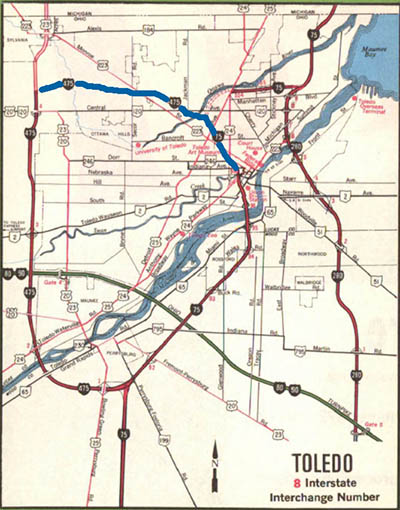
The 10 a.m. ribbon cutting took place on the west end of the highway in Sylvania, near the U.S. 23 interchange, after a breakfast. Despite the festivities, not everyone was happy. Especially Sylvania.
“Sylvania and Toledo officials, while acknowledging completion of the 8.8-mile Interstate 75-475 segment, admonished planning engineers and politicians to go back to the drawing boards in developing better accesses at both ends of the freeway section,” The Blade wrote. Boy, that’s gratitude for you.
“Mrs. Lucille Laskey, chairman of Sylvania Township trustees, and Sylvania Mayor Warren Schuster both complained that the multimillion dollar freeway provides no direct access to Sylvania and the township.
“Both expressed disappointment that no interchange was provided at Holland-Sylvania Road, adding that Sylvania motorists must go more than four miles to get onto the roadway which cuts through the center of their area. ‘We haven’t given up hope yet that we’ll get the Holland-Sylvania interchange,’ Mayor Schuster said.” (I would guess Sylvania has given up on that possibility.)
Had Sylvania officials been reading The Blade’s Zip Line attentively, they would have seen this letter from August 4, 1970:
With new Interstate 475 nearing completion, I was shocked to realize that there are no exits on my way home from work after Talmadge Road and none on my way to work until you reach Talmadge. The major through street, Holland-Sylvania Road, has no entrance or exit ramps. Why? – H.W., Sylvania Township.
A survey of motorists’ origin and destination and an analysis of population distribution and expected growth determined that an interchange at Holland-Sylvania was not feasible and a split interchange at Corey Road and Talmadge would serve the area, W. R. Greisiger, Ohio highway department division design and planning engineer, said. When considering traffic assignments to the various interchanges, the traffic capacity of existing street systems are considered and the major arterial routes utilized as feeder routes to the expressway, he added. In your case, Holland-Sylvania and Sylvania Avenue are considered feeder routes to I-475.
With the expressway open, The Blade sent out two reporters, Tom Davies and Tom Walton, to size up their commutes.
Davies, headed outbound from downtown, wrote that his biggest problem was getting through the traffic downtown to actually get to the highway. “It took me almost as long to get to 14th Street from Erie on Madison as it took me to get to the U.S. 23 interchange on the expressway from downtown.” That said, there was “something satisfying about being able to get on a highway after work and drive at 60 mph.”
Walton, who eventually rose from covering expressway openings to be editor and vice president of The Blade before retiring, started out from Bancroft and Reynolds but found he didn’t actually save much time since he had to drive out to the Central Ave. interchange to get on Interstate 475.
The expressway was the next-to-last link in Toledo’s expressway system. There was still one segment, from the 75/475 interchange near the former site of the Jeep plant to Interstate 280, that had yet to be built.
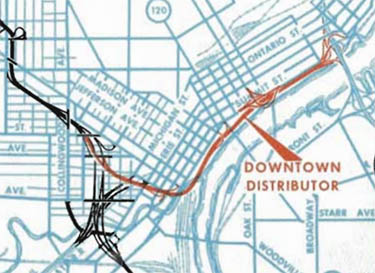
As an aside, there was a proposed, but never built, link of Toledo’s expressway system known as the Toledo Downtown Distributor. The distributor would have linked Interstate 75 with Interstate 280 and run right along the Maumee River, throwing traffic directly into downtown. I remember there used to be a “ramp to nowhere” off the Washington St. exit (202B) from southbound Interstate 75 that was intended to link to the downtown distributor, but there doesn’t seem to be any evidence of it anymore.
When the expressway opened, The Blade pushed for the completion of the distributor:
This is the key link that will carry the heavy volume of traffic into the central business district…bogged down by indecision, changing plans, and disagreement over routes, this distributor is still a number of years away; meanwhile, thousands of drivers who will be using the expressway in the downtown area are simply going to have to move from and to it over narrow city streets that were never designed to handle the volume expected.
Having lived in cities where the riverfront was cut off by an expressway, it’s my opinion they are generally abominations. Toledo should be thankful it was never built. Cincinnati is a good example: Fort Washington Way, a giant concrete trench of a highway, cut off downtown from the Ohio River. While the Maumee River has its issues, it is still a picturesque waterway (in my opinion).
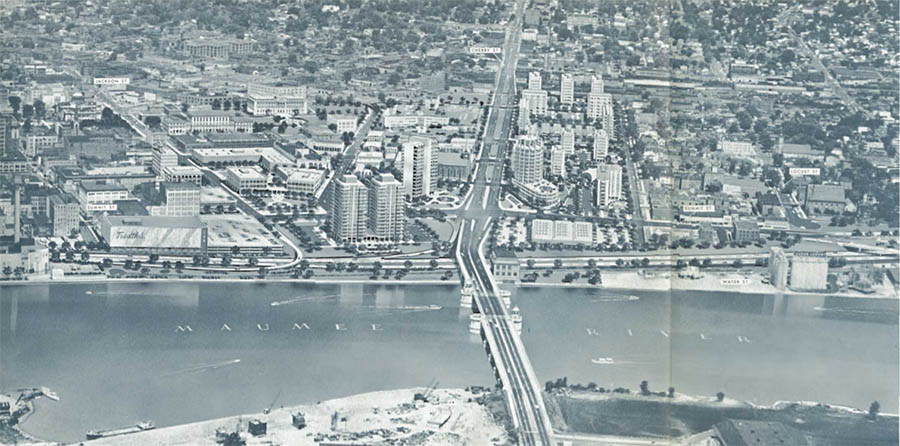
A few days later, C.E. Riser, Toledo traffic engineering commissioner, told The Blade the expressway was “working out much better than my fears had led me to believe it would.”
Computer traffic estimates, however, were a bit off: they underestimated traffic at Talmadge Road and overestimated it at the Secor Ave. and Monroe St. interchanges. A little tweaking of traffic signal sequences and timing was expected to solve the minor issues.
Ideas on how to solve Toledo’s traffic problems date from the end of the Second World War. In 1949, the City-County Plan Commission revealed their plans for Toledo’s expressway system and predicted it would take fifteen years to accomplish. The map below lays out their idea, although keep in mind this was before the National Interstate and Defense Highways Act of 1956, which planned and built most of the Interstate routes we drive on today.
Oddly, the first group to object to this proposal was a group of downtown businessmen: “We don’t want any inter-regional highway downtown, and no owner of downtown real estate asks or wants it downtown” was representative of the sentiment.

Interstate 475, which has had some major improvements made to it in the last ten years – new exits, a massive rebuild, new signage – was dedicated as the Rosa Parks Highway in 1990.
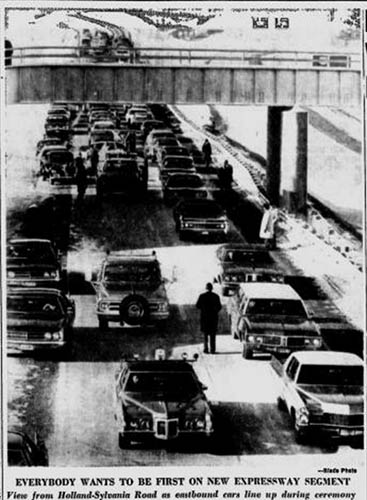
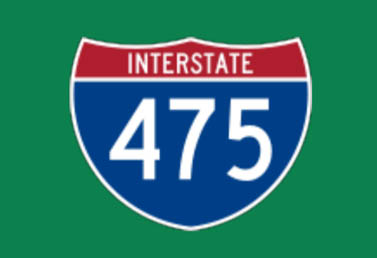
Before the entire length of I-475 was opened, it was opened in segments. Early on there was a segment open from Secor Rd to Talmadge, where the highway ended. One night a client of my late father got a speeding ticket on this section. My father disputed it in court, saying no speed limit was posted. In fact, the road was too new and no signs were erected. So the client got his ticket dismissed.
When was ground first broken for I75 in downtown Toledo?